
Discussion of my camera design
"formicula 2"
 © rm 1996
© rm 1996
OVERALL:
Advantages:
- Very cheap.
- Light.
- Very sturdy (and robust).
- No problems with vibrations.
- With some enthusiasm, usable as field camera too.
- Usable while it's raining or snowing.
Disadvantages:
- None! (This is a joke ;-)
Tilting and shifting camera adjustments (="movements") are not separated, i.e. if you loosen the front up/down/tilt lock both movements are no longer fixed, which is a bit inconvenient and may become a real problem in certain situations where you need to reproduce exact camera state.
Tilting/rotation axes are not exactly in the film plane, where they should be (only the most expensive commercial cameras are better here).
Takes some time to unpack/pack if used as field camera.
No automatics, everything to be done by hand, and in proper sequence.
No protection against operational mistakes (like opening the film holder light shield while the lens shutter is still open! Oh dear, how I hate that experience!)
IN DETAIL:
The best part IMHO of my design is the slide which carries the standard and glides on the rails. (There are two of these, one for the front standard and one for the back standard.) The stability, sturdiness and robustness of the whole camera result mostly out of the slide design. The central threaded bolt (M8) takes all the forces. When both focussing and movement screws are locked, the block parts of the slide are pressed together, between the metal base of the standard and the metal rails. No parts of the slide (except the threaded bolt) are pulled, only pushed. This is IMHO very important. No need to adjust anything to compensate wear-off, because locking is adjustment at the same time. (I.e. it is "self adjusting".)
Additionally the special arrangement of using the same threaded bolt at the same time for
- connecting the blocks of the slide in a rock-solid way
- attaching the standard resp. the monorail
yields another useful property: Focusing and camera movements (shifting and tilting) are separated completely.
Behind-Lens-Shutter
A feature I never used is the front standard frame box. I intended to build a shutter into this box, because my early lenses had no built-in shutter. From my first practical work I soon learned that a shutter is that part of a large format camera which is least necessary. Because of the permanent field-of-depth problems one is always forced to use small f-stops like 32, 45 or 64, so exposure times of 1/4 secs to 4 secs are usual under normal daylight conditions. These times are anyway best achieved using the lens cover, not with a shutter. (This is very true for commercial equipment too, while not known/accepted widely.)Changing lenses and orientation of back
The lens changing mechanism, and the back changing mechanism, are simple but convenient, better than some commercial ones.
Even if the lens lock is unlocked there is no danger for the lens to fall off. On the other hand, lens changing is fast.Nonstandard backs
This paragraph read: "Both of my camera backs have the problem that they do not accept current commercial film holders. When my old film holders will wear out some day, I will have to build a new back which has the standard dimensions for modern standardized film holders. Sigh!" Now this is history, I did build a new back, and it is compatible to the standard film holders. :-)
Tripod Head
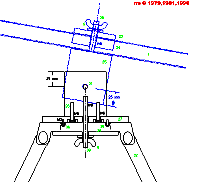 The same trick (the single threaded bolt taking all forces) as with the slides could not be applied to the tripod head because of the requirement for nivellation adjustment (= pointing the main axis more up or more down). I compensated this by using excessively big blocks, to achieve the stability needed in this crucial part. This was quite successful, I compared my tripod head to many others, and it is at least as stable as the others. I got some criticism for using a kind of plastic for these blocks, but anyone who has touched and felt it was convinced that it is absolutely stable. (Test: Use a long monorail, adjust the camera tightly and focus to a bright subject. Then try pressing down the end of the camera, and note how much the subject moves on the ground glass. This test could easily be made into a quantitative test procedure to compare tripod/heads.)
The same trick (the single threaded bolt taking all forces) as with the slides could not be applied to the tripod head because of the requirement for nivellation adjustment (= pointing the main axis more up or more down). I compensated this by using excessively big blocks, to achieve the stability needed in this crucial part. This was quite successful, I compared my tripod head to many others, and it is at least as stable as the others. I got some criticism for using a kind of plastic for these blocks, but anyone who has touched and felt it was convinced that it is absolutely stable. (Test: Use a long monorail, adjust the camera tightly and focus to a bright subject. Then try pressing down the end of the camera, and note how much the subject moves on the ground glass. This test could easily be made into a quantitative test procedure to compare tripod/heads.)Resummée:
While by no means perfect, my camera design has proven to be a valuable, dependable, but cheap, tool for making good photographs in the typical application domains of large format photography.
Current views of my camera in action
The following photos were taken in July/August 2001.
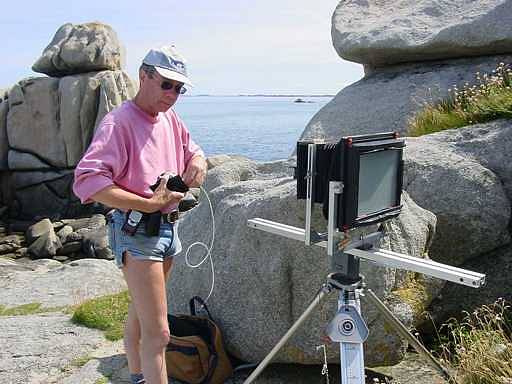
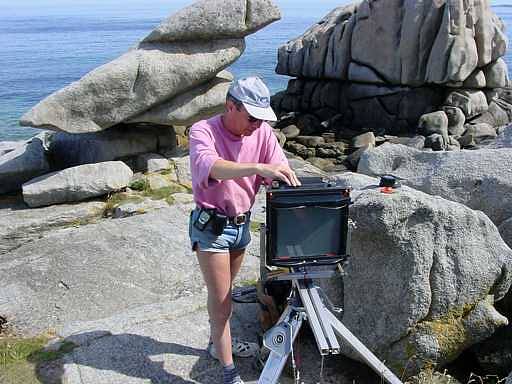

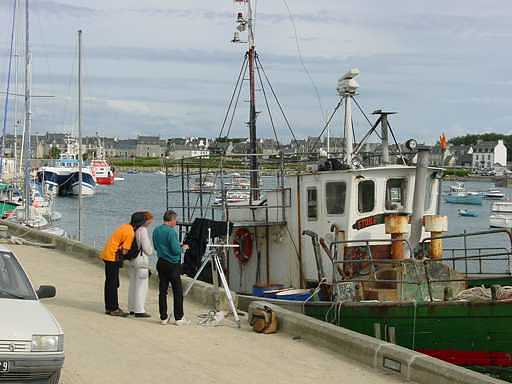
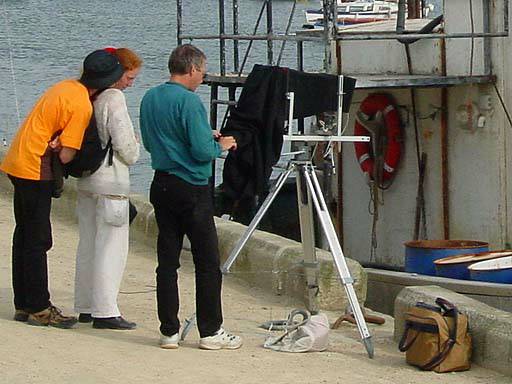


rudolf mittelmann © 1996-2001 rm








